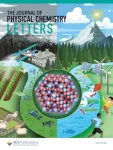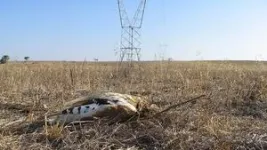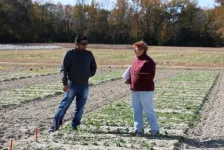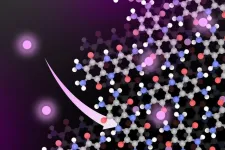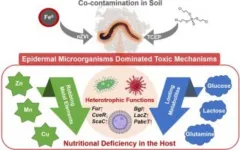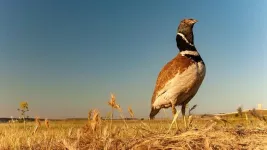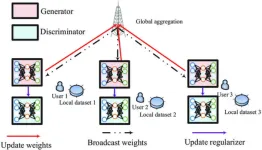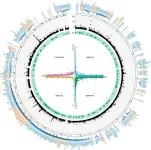(Press-News.org) WPI Researchers have developed a material to remove urea from water and potentially convert it into hydrogen gas. By building these materials of nickel and cobalt atoms with carefully tailored electronic structures, the group has unlocked the potential to enable these transition metal oxides and hydroxides to selectively oxidize urea in an electrochemical reaction.
The study, led by Xiaowei Teng, the James H. Manning professor of Chemical Engineering at WPI, was recently published in the Journal of Physical Chemistry Letters and highlighted in the publication’s supplementary front cover.
The Challenge of Removing Urea from Water
Urea is a low-cost nitrogen agriculture fertilizer and a natural product from human metabolism. Urea-rich agricultural runoff and municipal wastewater discharge cause eutrophication–harmful algal blooms and hypoxic dead zones that adversely impact the aquatic environment and human health.
At the same time, the unique characteristics of urea make it a potential hydrogen storage medium that could offer viable on-demand hydrogen production. For instance, urea is non-toxic, has high water solubility, and has high hydrogen content (6.7% by weight). Thus, urea electrolysis for hydrogen production is more energy-efficient and economical than water electrolysis.
The weakness of urea electrolysis has always been the lack of low-cost and highly efficient electrocatalysts that selectively oxidize urea instead of water, but Teng and his team have found a solution: making electrocatalysts consisting of synergistically interacted nickel and cobalt atoms with unique electronic structures for selective urea electro-oxidation.
Unlocking Enhanced Selectivity and Activity
The WPI team’s study centered on homogeneous nickel and cobalt oxides and hydroxides. Researchers found that the key to enhancing its electrochemical activity and selectivity to urea oxidation lay in tailoring the unique electronic structures with dominant Ni2+ and Co3+ species.
“This electronic configuration is a pivotal factor to improve the selectivity of urea oxidation because we observe that higher nickel valence, such as Ni3+, indeed helps produce a fast reaction with strong electric current output; however, a large portion of current was from unwanted water oxidation,” Teng said.
To better understand this effect, Teng’s group collaborated with Aaron Deskins, a professor of chemical engineering at WPI. Deskins performed the computational simulations and found that homogenous mixing of nickel and cobalt oxides and hydroxides benefited the electron redistribution from Ni2+ to Co3+ species and shifting valence electrons to higher energy so the Ni/Co catalysts were better prepared to participate in bonding with urea and water molecules.
Applications and Future Prospects
A major nitrogen fertilizer and feed additive, urea was commercially produced as early as the 1920s; around 180 million metric tons were produced in 2021. Urea can be derived from natural sources; an adult human produces 1.5 L of urine daily, equivalent to 11 kg of urea and 0.77 kg of hydrogen gas yearly.
The team’s findings could help use urea in waste streams to efficiently produce hydrogen fuel through the electrolysis process, and could be used to sequester urea from water, maintaining the long-term sustainability of ecological systems, and revolutionizing the water-energy nexus.
Reference: “Enhanced Urea Oxidation Electrocatalytic Activity by Synergistic Cobalt and Nickel Mixed Oxides” by Tongxin Zhou, Sathya Narayanan Jagadeesan, Lihua Zhang, N. Aaron Deskins, and Xiaowei Teng, Journal of Physical Chemistry Letters, 2024, 15, 1, 81-89.
doi.org/10.1021/acs.jpclett.3c03257
This work was supported by the National Science Foundation under Award Number 2236704.
END
Efficiently moving urea out of polluted water is coming to reality
Worcester Polytechnic Institute researchers unlock secret to upcycling organic compound
2024-01-18
ELSE PRESS RELEASES FROM THIS DATE:
Researchers awarded $2.7 million grant to develop the faba bean as a sustainable mid-Atlantic crop
2024-01-18
Consider the faba bean, also known as the fava bean or broad bean.
The bright-green legume has been enjoyed as a diet staple for thousands of years in Africa, Asia, and the Mediterranean. Just one cup of faba beans has 13 grams of protein — making it a better protein source than most other legumes — along with plenty of fiber, potassium, and iron. Plus, it’s a good cover crop that helps improve soil health, slow erosion, and control pests, disease, and weeds.
But you don’t often see it in the fields or on the menus in Virginia.
That’s why College of Agriculture and Life ...
Cobalt-free batteries could power cars of the future
2024-01-18
CAMBRIDGE, MA – Many electric vehicles are powered by batteries that contain cobalt — a metal that carries high financial, environmental, and social costs.
MIT researchers have now designed a battery material that could offer a more sustainable way to power electric cars. The new lithium-ion battery includes a cathode based on organic materials, instead of cobalt or nickel (another metal often used in lithium-ion batteries).
In a new study, the researchers showed that this material, which could be produced at much lower cost than cobalt-containing batteries, can conduct electricity at similar rates as cobalt batteries. The new battery also has comparable storage ...
New study reveals the impact of skin microorganisms on earthworm toxicity in polluted environments
2024-01-18
Epidermal microorganisms, vital in nutrient exchange between hosts and environments, have now been shown to play a key role in host toxicity through community changes. This research highlights how changes in the community of skin-based microbes correlate more significantly with earthworm toxicity than those in intestinal microorganisms, especially under combined soil contaminations.
A new study (https://doi.org/10.1016/j.eehl.2023.11.001) published in the journal Eco-Environment & Health, researchers from Zhejiang University revealed the crucial role of epidermal microorganisms in influencing earthworm toxicity under environmental stress, notably in conditions ...
Scientists, farmers and managers work together to avoid the decline of the little bustard, an endangered steppe bird
2024-01-18
The collaboration between scientists, farmers and managers is crucial to improve the protection of the little bustard, an endangered steppe-land bird in Spain due to human activity. The reduction of natural habitats, the increase in irrigation and the urbanization of the land have led to having less surface areas that guarantee the survival of this vulnerable species. An article published in the journal Biological Conservation reveals how cooperation between different actors is key to finding answers and avoiding the decline of the most threatened populations of the little bustard.
The study, a pioneer example of adaptative conservation, ...
Better wireless communication made possible through machine learning
2024-01-18
In today's increasingly interconnected world, high-quality communication has become more vital than ever. Accurately estimating the dynamic status of communication channels is a key factor in achieving this. Recently, a joint research team designed a new algorithm that offers high-level estimation accuracy and privacy protection with low computational and communication costs. This research was published Jan. 5 in Intelligent Computing, a Science Partner Journal.
This new algorithm uses a specially designed deep learning model for precise estimation and a federated learning framework ...
Study with over 11,000 individuals of African descent finds genetic variants linked to glaucoma
2024-01-18
Glaucoma is the leading cause of irreversible blindness around the globe, affecting up to 44 million people. Although people of African ancestry are most frequently and severely affected by this hereditary disease, its genetic underpinnings in this population have rarely been studied. Now, a team of investigators has published findings revealing previously unknown inherited genetic variants that contribute to primary open-angle glaucoma (POAG), the most common form of the disease. The study was based on the analysis of 11,275 individuals of African descent and is being published January 18, 2024, in Cell.
“Individuals with African ancestry are five times more likely to be affected ...
Economics: Sea level rises could cost EU and UK economies up to 872 billion Euros by 2100
2024-01-18
Damage caused by sea level rises could cost the EU and UK economies up to 872 billion Euros in total by the end of the century, according to a modelling study published in Scientific Reports.
Ignasi Cortés Arbués, Theodoros Chatzivasileiadis, Tatiana Filatova and colleagues modelled the potential economic impacts of sea level rises for 271 European regions by 2100 under a high emissions scenario (SSP5-RCP8.5) with no new coastal protection measures implemented after 2015. They combined ...
Genetics: Chewing over poor Mesolithic oral health
2024-01-18
Members of a hunter-gatherer group that lived in south-western Scandinavia during the Mesolithic era — approximately 10,000 years ago — may have been affected by tooth decay and gum disease, according to a study published in Scientific Reports.
Emrah Kırdök, Anders Götherström and colleagues sequenced the DNA found on three pieces of birch tar — a substance made from heated birch bark — that were excavated in the 1990s from Huseby Klev, Sweden and have been dated to between 9,890 ...
Mega-analysis identifies gene variants associated with glaucoma in people of African ancestry
2024-01-18
PHILADELPHIA— A new analysis focusing specifically on people of African ancestry identified three gene variants that may be contributing to this population’s susceptibility to developing and being blinded by glaucoma. People of African ancestry are five times as likely as others to develop glaucoma and up to 15 times as likely to be blinded by the condition, but the vast majority of research has used data from people of European ancestry. Led by researchers at the Perelman School of Medicine at the University ...
Third major study finds evidence that daily multivitamin supplements improve memory and slow cognitive aging in older adults
2024-01-18
By 2060, according to the Alzheimer’s Association, nearly one in four Americans will be in an age bracket at elevated risk of cognitive decline and Alzheimer’s disease unless interventions can help preserve cognitive function before deficits begin. The COcoa Supplement and Multivitamin Outcomes Study (COSMOS) is a large-scale, nationwide, randomized trial rigorously testing cocoa extract and multivitamin supplements directed by researchers at Mass General Brigham. Two previously published studies of cognition in COSMOS suggested a positive effect for a daily multivitamin. ...
LAST 30 PRESS RELEASES:
Scientists boost cell "powerhouses" to burn more calories
Automatic label checking: The missing step in making reliable medical AI
Low daily alcohol intake linked to 50% heightened mouth cancer risk in India
American Meteorological Society announces Rick Spinrad as 2026 President-Elect
Biomass-based carbon capture spotlighted in newly released global climate webinar recording
Illuminating invisible nano pollutants: advanced bioimaging tracks the full journey of emerging nanoscale contaminants in living systems
How does age affect recovery from spinal cord injury?
Novel AI tool offers prognosis for patients with head and neck cancer
Fathers’ microplastic exposure tied to their children’s metabolic problems
Research validates laboratory model for studying high-grade serous ovarian cancer
SIR 2026 delivers transformative breakthroughs in minimally invasive medicine to improve patient care
Stem Cell Reports most downloaded papers of 2025 highlight the breadth and impact of stem cell research
Oxford-led study estimates NHS spends around 3% of its primary and secondary care budget on the health impacts of heat and cold in England
A researcher’s long quest leads to a smart composite breakthrough
Urban wild bees act as “microbial sensors” of city health.
New study finds where you live affects recovery after a hip fracture
Forecasting the impact of fully automated vehicle adoption on US road traffic injuries
Alcohol-related hospitalizations from 2016 to 2022
Semaglutide and hospitalizations in patients with obesity and established cardiovascular disease
Researchers ‘listen in’ to embryo-mother interactions during implantation using a culture system replicating the womb lining
How changing your diet could help save the world
How to make AI truly scalable and reliable for real-time traffic assignment?
Beyond fragmented markets: A new framework for efficient and stable ride-pooling
Can shape priors make road perception more reliable for autonomous driving?
AI tracks nearly 100 years of aging research, revealing key trends and gaps
Innovative techniques enable Italy’s first imaging of individual trapped atoms
KIER successfully develops Korea-made “calibration thermoelectric module” for measuring thermoelectric device performance
Diversifying US Midwest farming for stability and resilience
Emphasizing immigrants’ deservingness shifts attitudes
Japanese eels, climate change, and river temperature
[Press-News.org] Efficiently moving urea out of polluted water is coming to realityWorcester Polytechnic Institute researchers unlock secret to upcycling organic compound
